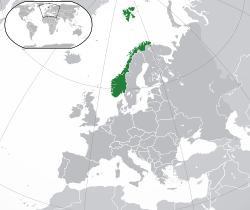List of possessions of Norway
This is a list of territorial possessions of Norway.

Current possessions

Integral overseas areas of Norway, although unincorporated:
- Svalbard including Bear Island, possession since 1920.
- Jan Mayen, possession since 1929.
Svalbard with Bear Island are subject to the provisions of the Svalbard Treaty. Svalbard and Jan Mayen are grouped together for some categorization purposes.
Current dependencies of Norway are all in the southern polar region:
- Peter I Island, in Antarctica, possession since 1929.
- Bouvet Island, in Sub-Antarctic, possession since 1930.
- Queen Maud Land, in Antarctica, possession since 1939.
Former dependencies and homelands



The so-called Greater Norway includes these entities:
Dependencies ceded to Scotland (1st phase)
- Hebrides, colonized from 700s to 1100s, part of an earldom, crown dependencies from 1100s to 1266, ceded by the Treaty of Perth.
- Man, colonized from 850s to 1152, part of an earldom, crown dependency from 1152 to 1266, ceded by the Treaty of Perth.
- Orkney, colonized from 800s to 875, earldom from 875 to 1100s, crown dependency from 1100s to 1469, pledged by Christian I .
- Shetland, colonized from 700s to 900s, earldom from 900s to 1195, crown dependency from 1195 to 1469, pledged by Christian I .
Uncertain transfere
- Caithness, recognized as fully Scottish since the Treaty of Perth in 1266.
National homelands ceded to Sweden (2nd phase)
- Bohuslän, integrated from 800s to 1523, again from 1532 to 1658, ceded by the Treaty of Roskilde.
- Idre & Särna, integrated from ??? to 1645, ceded by the Second Treaty of Brömsebro, border not formally deliniated until 1751.
- Jämtland, integrated from 1100s to 1645, ceded the Second Treaty of Brömsebro.
- Härjedalen, integrated from 1200s to 1563, again from 1570 to 1645, ceded by the Second Treaty of Brömsebro.
Early entity
- Värmland, from as early as 820 (pre-unification) to about 1000, before being integrated into Sweden.
Briefly-ruled Danish-Swedish homelands
- Kungsbacka, Varberg & Falkenberg, historical Northern Halland, part of the kingdom from 1287 to 1305.
Briefly-ruled Swedish homelands
- Västergötland, Dalsland & Värmland, part of the kingdom from 1374 to 1380.
Dependencies ceded to Denmark (3rd phase)
- Faroe Islands, settled and colonized pre-1035 and crown dependencies from 1035 to 1814, ceded by the Treaty of Kiel.
- Greenland, colonized pre-1261 and crown dependency from 1261 to 1814, ceded by the Treaty of Kiel.
- Iceland, settled and colonized pre-1262 and crown dependencies from 1262 to 1814, ceded by the Treaty of Kiel.
Ceding era explained
The actual time for the ceding of the islands is somewhat disputed. Denmark claims it took place with the Union of Denmark and Norway in 1536, as the possessions of the Norwegian crown were claimed by the Danish king. Nevertheless, they were still referred to as "dependencies of Norway" in later official documents. Also the Treaty of Kiel states: "...and provinces, constituting the kingdom of Norway, [..], together with their dependencies (Greenland, the Faroe Isles, and Iceland, excepted); [...] shall belong in full and sovereign property to the King of Sweden,...", clearly indicating that they were until 1814 regarded as a part of Norway.
Briefly-ruled Danish kingdom
- Denmark inc. Halland, Scania & Blekinge of present-day Sweden - historicaly Skåneland, part of the kingdom from 1042 to 1047.
Former Norse kingdoms outside Scandinavia
Kingdom entities
Norwegian legacy kingdoms subsequently integrated into Norway and Ireland:
- Kingdom of Mann and the Isles, kingdom from 800s to 1200s.
- Kingdom of Dublin, kingdom from 839 to 1170.
- Earldom of Orkney, earldom from 875 to 1100s.
- Icelandic Commonwealth, state from 930 to 1262.
Joint kingdom entities with the Danes
Dano-Norwegian legacy kingdoms subsequently integrated into England and France:
- Duchy of Normandy, duchy ruled by Norwegians, Danes and their descendants from 911 to 1259.
- Kingdom of York, kingdom ruled first by Danes and later by Norwegians from 876 to 954.
- Kingdom of Northumbria, kingdom from 914 to 954, after Danish rule.
Former contested possessions and claims
England
- The Kingdom of England, now part of United Kingdom, claimed by several Norwegian kings of the 11th century.
Africa
- German East Africa, now part of Tanzania, Burundi and Rwanda.
Baron Fritz Wedel Jarlsberg, Norwegian ambassador to Paris, enjoyed a high level of popularity and influence in the French capital. Through diplomacy, he had originally intended for The Treaty of Versailles to have Germany cede German East Africa to Norway in 1919 in compensation for the loss of men and ships in WWI during which Norway had declared itself neutral. The liberal political party Venstre which was elected to government in Norway, opposed the conservative view on colonization and denied the offer which Jarlsberg had successfully secured in France.
Arctic
- Fridtjof Nansen Land, now part of Russia, claimed from 1926 to around 1929, rejecting a claim of the Soviet Union.
- Sverdrup Islands, now part of Canada, claimed from 1928, Canadian sovereignty recognised in 1930.
- Erik the Red's Land, northeast coast of Greenland, claimed from 1931 until awarded to Denmark by a court decision in 1933.
Finland and Russia
- Inari and Petsamo, now part of Finland and Russia, claimed from Finland from about 1942 to 1945 by the Quisling regime during the Nazi occupation of Norway.
- Murmansk and Arkhangelsk as Bjarmland, now part of Russia, claimed from the Soviet Union from about 1942 to 1945 by the Quisling regime.
See also
- Norgesveldet for more detailed information on Norway's former possessions
- Norse colonization of the Americas
- Danish colonial empire for Dano–Norwegian colonies
- Dependencies of Norway
- Irredentism
